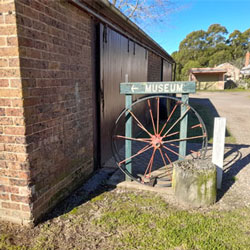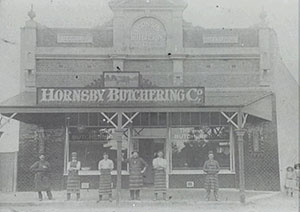Landscape heritage
Landscape heritage captures cultural and natural landscape areas, places and elements which embody the one or more of the diverse values of heritage significance. These may be defined as:
- Designed landscapes are created intentionally. They include gardens and parkland landscapes constructed or planted for aesthetic reasons, such as trees, avenues, parks, gardens, cemeteries and plazas.
- Organically evolved landscapes or 'vernacular' landscapes are developed over time in response to, and association with, the natural environment. Organically evolved landscapes often develop through changes brought about by patterns of use. They fall into two subcategories: a relict landscape where an evolutionary process has ended; and a continuing landscape where the evolutionary process is still in progress. They include farming landscapes, industrial landscapes such as goldfields, and linear landscapes such as railway lines.
- Associative landscapes primarily based on religious, spiritual, artistic or cultural associations with the natural environment. Associative landscapes are often significant for their intangible, non-physical values associated with events, activities or significant people. They include landscapes such as Aboriginal places, explorers' routes, river crossings or places where significant events have occurred. They also include landscapes that have stories told about them. Documents and oral histories relating to what happened at the place are especially important in identifying and assessing how people interacted with these types of landscapes.
The cultural values of landscapes, as with all types of heritage items, can relate to their aesthetic, archaeological, historical, scientific, social, or architectural values, any or all of which may co-exist in the one place. These values may be significant to communities at local, state, national or world (universal) levels.
- Natural heritage is defined by The Australian Natural Heritage Charter as comprising the natural living and non-living components, that is, the biodiversity and geodiversity, of the world that we inherit
Natural heritage fundamentally differs from cultural heritage, although places may be considered of both cultural natural heritage, as it is defined as:
- natural features consisting of physical and biological formations or groups of such formation, which demonstrate natural significance
- geological or physiological formations and precisely delineated areas that constitute the habitat or indigenous species of animals and plants which demonstrate natural significance, and / or * natural site or precisely delineated natural areas which demonstrate natural significance from the point of view of science, conservation or natural beauty.
Landscape heritage in Hornsby Shire
Landscape heritage items within Hornsby Shire are listed within Schedule 5 – Part 1 Heritage Items within the Hornsby Local Environmental Plan 2013 - NSW Legislation.
Many items may have an individual listing or dual listing with a built heritage item, such as house and garden, or listed as an archaeological site.
Examples of landscape heritage in Hornsby Shire include:
Landscape Heritage | Categories within Hornsby Shire | Quantity | Description |
Organically evolved | Bushland | 35 | Bushland sites of the Shire which have heritage significance primarily for the bushland they conserve. |
Designed landscape | Gardens bushland | 3 | Gardens that include endemic bushland or remnants of bushland which are the primary reasons for significance. |
Designed landscape | Gardens cultural | 97 | Historic designed landscape where the form, layout and/or designer are the primary reasons for significance. |
Designed landscape | Landscape Structures | 38 | Individual items in the landscape which may be historically important garden walls, fences, steps, culverts and depression |
Designed /Associative landscapes | Memorials | 9 | A memorial to a person/s, place or event/s frequently with associated structures or tangible remains that promote understanding and interpretation of events, ideas or persons. |
Designed landscape | Parklands | 48 | Parklands, sports fields and passive recreation areas but also recreational landscapes such as golf courses and rifle range. |
Associative landscapes | Schools, Churches grounds | 25 | The landscape curtilage of schools, churches and institutional landscapes such as Mowll Village and the Baden Powell Scout Centre. |
Designed landscape | Street trees cultural | 10 | Exotic and native (but not endemic) street trees usually of a single species laid out as avenues with even spacings. |
Organically evolved | Street trees natural | 46 | Naturally occurring endemic trees remaining in the street verge. Not planted. |
Organically evolved | Trees cultural | 17 | Individual exotic and natural (but not endemic) trees or groups of trees which are the primary reason for significance of a listing. |
Organically evolved | Trees natural | 2 | Individual or groups of naturally occurring endemic trees which are the primary reason for significance of a listing. |
Associative landscapes | Viewscapes/ Scenic landscapes | 2 | Landscapes which are historically significant for the view that the site affords and visually impactful places |
Associative landscapes | Windbreaks | 7 | Intentionally planted rows of trees to ameliorate the impact of strong winds, usually associated with rural areas |
To find out if a particular property is listed as a landscape heritage item refer to:
- Schedule 5 within the Hornsby Local Environmental Plan 2013 – NSW Legislation
- Council’s online Property Enquiry
- Council’s online Mapping System
For further information on an items landscape heritage significance, refer to Council’s online Heritage register.
Management of landscape heritage
Hornsby Shire Council completed its first Landscape heritage study (PDF 3.8MB) under the 1993 Hornsby Shire Heritage Study and has been the leading document to guide and promote the conservation and management practices of Landscape Heritage within Hornsby Shire for the past 25 years.
A new and updated Landscape Heritage Study is currently being prepared under the Comprehensive Heritage Study.
Refer to Part 9 of the Hornsby Development Control Plan for general development guidelines to undertake work on land that may contain a Landscape Heritage Item or values of Landscape heritage significance.
Renovating a Home
Buying and Selling

Celebrating our heritage through interpretation

Have your say on Hornsby Shire's heritage
Hornsby Shire Council values feedback from the community on what local residents regard as their local heritage.







